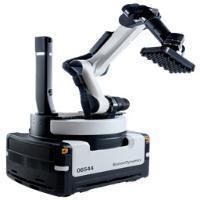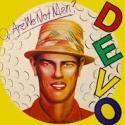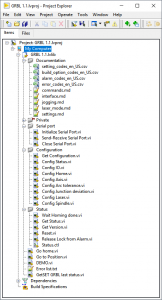Leaderboard
Popular Content
Showing content with the highest reputation since 06/21/2020 in all areas
-
Dear Santa NI I am now in my 40s with youngish kids, so despite the fact that all I got for Christmas this year was a Pickle Rick cushion I am not actually complaining. However, I would like to get my order in to the Elves as early as possible. This is my wishlist, in no particular order. I expect this list will not be to everyone's taste, this is ok, this is just my opinion. Make LabVIEW free forever. The war is over, Python has won. If you want to be relevant in 5 to 10 years you need to embrace this. The community edition is a great start but is is probably not enough. Note: I accept it might be necessary to charge for FPGA stuff where I presume you license Xilinx tools. NI is and has always been a hardware company. Make all toolkits free. See the above point. Remove all third party licensing stuff. Nobody makes any money from this anyway. Encourage completely open sharing of code and lead by example. Take all the software engineering knowledge gained during the NXG experiment and start a deep refactor of the current gen IDE. Small changes here please though... we should not have to wait 10 years. Listen to the feedback of your most passionate users during this refactor. NXG failed because you ignored us and just assumed we would consume whatever was placed in front of us. I am talking about the people like those reading this post on Christmas day and their spare time because they are so deeply committed to LabVIEW My eyes are not what they used to be, so please bring in the NXG style vector graphic support so I can adjust the zoom of my block diagram and front panel to suit accordingly As part of the deep refactor, the run-time GUI needs to be modernised. We need proper support for resizable GUIs that react sensible to high DPI environments. Bring the best bits of NXG over to current gen. For example the dockable properties pane. (Sorry not much else comes to mind) Remove support for Linux and Mac and start to prune this cross compatibility from the codebase. I know this is going to get me flamed for eternity from 0.1 % of the users. (You pretty much made this decision for NXG already). Windows 10 is a great OS and has won the war here. Get rid of the 32-bit version and make RT 64-bit compatible. You are a decade overdue here. Add unicode support. I have only needed this a few times, but it is mandatory for a multicultural language in 2021 and going forward Port the Web Module to Current Gen. All the news I have heard is that the Web Module is going to become a standalone product. Please bring this into Current Gen. This has so much potential. Stop adding features for a few years. Spend the engineering effort polishing. Fix the random weirdness we get when deploying to RT Open source as many toolkits as you can. Move the Vision toolkit over to OpenCV and make it open source Sell your hardware a bit cheaper. We love your hardware and the integration with LabVIEW but when you are a big multiple more expensive than a competitor it is very hard to justify the cost. Allow people to source NI hardware through whatever channel makes most sense to them. Currently the rules on hardware purchasing across regions are ridiculous. Bring ni.com into the 21st century. The website is a dinosaur and makes me sad whenever I have to use it Re-engage with universities to inspire the next generation of young engineers and makers. This will be much easier if the price is zero Re-engage with the community of your most passionate supporters. Lately it has felt like there is a black hole when communicating with you Engineer ambitiously? What does this even mean? The people using your products are doing their best, please don't patronise us with this slogan. Take the hard work done in NXG and make VIs into a non-binary format human readable so that we can diff and merge with our choice of SCC tools Remove all hurdles to hand-editing of these files (no more pointless hashes for "protection" of .lvlibs and VIs etc) Openly publish the file formats to allow advanced users to make toolkits. We have some seriously skilled users here who already know how to edit the binary versions! Embrace this, it can only help you. Introduce some kind of virtualenv ala Python. i.e. allow libraries and toolkits to be installed on a per-project basis. (I think this is something JKI are investigating with their new Project Dragon thing) For the love of all that is holy do not integrate Git deeply into LabVIEW. Nobody wants to be locked into someone else's choice of SCC. (That said, I do think everyone should use Git anyway, this is another war that has been won). That is about it for now. All I want is for you guys to succeed so my career of nearly 20 years does not need to be flushed down the toilet like 2020. Love you Neil (Edited: added a few more bullets)16 points
-
I did not know. That possibility was not even on my radar. Even though the drumbeat of bad news had been going for a while, most corporations refuse to change direction on a bad decision. NI showed more sentience than I usually expect from massed humans: the sunk cost fallacy is a trap that is very hard to get out of. I figured the very good engineers on NXG would either surge through it and make it fly or we would bankrupt the company trying. That's the pattern established by plenty of other companies. Mixed. I spent 4.5 years directly working on NXG (2011 to 2016) and countless hours in later years working with the NXG team to design a future G. I really wanted it to fly. There is so much good in that IDE, including some amazing things that I just don't see how we ever do in the LabVIEW codebase without just shattering compatibility. But at the same time, I was watching good friends toil on something that the market just wasn't adopting. The software had some problems that were going to take a long time to solve. The issues were all solvable, but the time needed to fix them... that was harder and harder to justify. NXG gave us a GREAT platform for other software: Veristand, FlexLogger, etc. That code is extremely modular and can be repurposed for all sorts of tools. We also learned a heck of a lot by building NXG -- some things that I thought we could never do in LabVIEW now seem possible. NXG gave us a sandbox to learn a whole lot about modern software engineering without putting the delivery schedule for mature software at risk, and those practices [have been|are being] brought back and applied to LabVIEW -- that will decrease cost of maintaining older code. All in all, NXG was valuable -- the expenditure was not a complete loss. I am very sorry to the few customers who did migrate to NXG. We don't have a reverse migration tool, and building one would be absurdly expensive. Leaving those folks stranded is going to hurt -- I hate letting our customers down and just saying, "We have no solution to help you." There aren't many of those folks (that's essentially the problem), but they do exist, and they are basically stuck having to rewrite their NXG apps in some other tool. I can only hope that they pick LabVIEW. I don't know if this will help us or hurt us with customers in the future... on one hand, people may say, "Well, you let us down on NXG, why should we trust you will be there for us on any new products?" On the other hand, this decision was clearly made listening to customer feedback, and it takes a lot of humility to swallow a loss that big, which may make customers trust our judgement more in the future. And, really, there's nothing to compare with the scale of NXG -- an entire computing platform -- so this does seem like something that needs to be judged in isolation. I really like programming in G. I like being able to expand G to make it more powerful. I wanted NXG to succeed because it had the potential to be a better G. It failed. Its failure means more resources for the existing LabVIEW platform, which will directly help our customers in the short run. It leaves open some big questions for the long run. So, in summary: I think it was a decision that had to be made, and I'm happy to work for a company that can learn from new data, then admit a mistake, and then figure out how to correct it.15 points
-
“There was this fence where we pressed our faces and felt the wind turn warm and held to the fence and forgot who we were or where we came from but dreamed of who we might be and where we might go...” -- Opening lines of “R is for Rocket” by Ray Bradbury I spent 20 years building this G language of ours. It’s time for me to go enjoy the fruits of that labor as a user! I will still be employed by NI, but I will be working full time for Blue Origin. As part of the NI “Engineer in Residence” program, I will be on loan to Blue Origin to revise their engine and support test systems. They wanted a Certified LabVIEW Architect with deep knowledge of LVOOP, multiple years of experience with Actor Framework, and deep knowledge of cRIO and PXI. I asked, “Can we negotiate on that last part?” They said, “Yes, yes we can.” Turns out, based on the interview, I know more than I thought – apparently some hardware knowledge does rub off just by sitting near it for a couple decades. This new job runs for six months, but it is extensible through the end of 2021 at the discretion of myself and Blue Origin. When I come back, I do not know if I will be returning to LabVIEW. Spaceflight has long been a passion of mine. Over my 20 years with LabVIEW R&D, I have had the chance to help out with various Mars rovers, large telescopes, and rocket launches. It has been awesome, and I’m proud of the language advances I brought to LabVIEW that helped so many users along the way. Now, I am going to focus on just one customer for a while... a customer with very large rocket engines! My last day will be Friday, October 23. I will not have the same availability to respond to posts as I have in the past, but Aristos Queue will still be around on the forums. “And, walking, I went beyond the fence.” -- ending of “R is for Rocket”12 points
-
To all things there is a season. Jeff Kodosky helped found National Instruments and invented LabVIEW. He inspired hundreds of us who shapes its code across four decades. But Jeff says it is time to change his focus. Today, NI announced Jeff’s retirement. He will probably always be noodling around on LabVIEW concepts and will remain open to future feature discussions. But his time as a developer is done. Maybe you didn’t know that? Jeff still slings code, from big features to small bugs. He’s been a developer most of the years, happy to have others manage the release and delivery of his software. I spent over two decades working at his side. He taught me to look for what customers needed that they weren’t asking for, to understand what problems they didn’t talk about because they thought the problems were unsolvable. And he built a team culture that made us all collaborators instead of competitors. Thank you, Jeff, for decades of brilliant ideas and staying the course to see those develop into reality. Your work will continue on as one of the key tools on humanity’s expansion to Mars.11 points
-
June 3 will be my last working day at NI. After almost 22 years, I'm stepping away from the company. Why? I found a G programming job in a field I love. Starting June 20, I'm going to be working at SpaceX on ground control for Falcon and Dragon. This news went public with customers at NI Connect this week. I figured I should post to the wider LabVIEW community here on LAVA. I want to thank you all for being amazing customers and letting me participate vicariously in so many cool engineering projects over the years. I'm still going to be a part of the LabVIEW community, but I'm not going to be making quite such an impact on G users going forward... until the day that they start needing developers on Mars -- remote desktop with a multi-minute delay between mouse clicks is such a pain! 🙂11 points
-
How Software Companies Die – Orson Scott Card The environment that nurtures creative programmers kills management and marketing types - and vice versa. Programming is the Great Game. It consumes you, body and soul. When you're caught up in it, nothing else matters. When you emerge into daylight, you might well discover that you're a hundred pounds overweight, your underwear is older than the average first grader, and judging from the number of pizza boxes lying around, it must be spring already. But you don't care, because your program runs, and the code is fast and clever and tight. You won. You're aware that some people think you're a nerd. So what? They're not players. They've never jousted with Windows or gone hand to hand with DOS. To them C++ is a decent grade, almost a B - not a language. They barely exist. Like soldiers or artists, you don't care about the opinions of civilians. You're building something intricate and fine. They'll never understand it. Beekeeping - Here's the secret that every successful software company is based on: You can domesticate programmers the way beekeepers tame bees. You can't exactly communicate with them, but you can get them to swarm in one place and when they're not looking, you can carry off the honey. You keep these bees from stinging by paying them money. More money than they know what to do with. But that's less than you might think. You see, all these programmers keep hearing their fathers' voices in their heads saying "When are you going to join the real world?" All you have to pay them is enough money that they can answer (also in their heads) "Jeez, Dad, I'm making more than you." On average, this is cheap. And you get them to stay in the hive by giving them other coders to swarm with. The only person whose praise matters is another programmer. Less-talented programmers will idolize them; evenly matched ones will challenge and goad one another; and if you want to get a good swarm, you make sure that you have at least one certified genius coder that they can all look up to, even if he glances at other people's code only long enough to sneer at it. He's a Player, thinks the junior programmer. He looked at my code. That is enough. If a software company provides such a hive, the coders will give up sleep, love, health, and clean laundry, while the company keeps the bulk of the money. Out of Control - Here's the problem that ends up killing company after company. All successful software companies had, as their dominant personality, a leader who nurtured programmers. But no company can keep such a leader forever. Either he cashes out, or he brings in management types who end up driving him out, or he changes and becomes a management type himself. One way or another, marketers get control. But...control of what? Instead of finding assembly lines of productive workers, they quickly discover that their product is produced by utterly unpredictable, uncooperative, disobedient, and worst of all, unattractive people who resist all attempts at management. Put them on a time clock, dress them in suits, and they become sullen and start sabotaging the product. Worst of all, you can sense that they are making fun of you with every word they say. Smoked Out - The shock is greater for the coder, though. He suddenly finds that alien creatures control his life. Meetings, Schedules, Reports. And now someone demands that he PLAN all his programming and then stick to the plan, never improving, never tweaking, and never, never touching some other team's code. The lousy young programmer who once worshiped him is now his tyrannical boss, a position he got because he played golf with some sphincter in a suit. The hive has been ruined. The best coders leave. And the marketers, comfortable now because they're surrounded by power neckties and they have things under control, are baffled that each new iteration of their software loses market share as the code bloats and the bugs proliferate. Got to get some better packaging. Yeah, that's it. Originally from Windows Sources: The Magazine for Windows Experts, March 199511 points
-
Update to this post: My sabbatical has ended. I went from Blue Origin to Microsoft, but as of a couple weeks ago, I have now returned to LabVIEW development. At some point, I may put together a public summary of my experiences as a full-time G dev. For now, be assured that I am feeding that experience back into the feature backlog priority list!10 points
-
TDF team is proud to propose for free download the scikit-learn library adapted for LabVIEW in open source. LabVIEW developer can now use our library for free as simple and efficient tools for predictive data analysis, accessible to everybody, and reusable in various contexts. It features various classification, regression and clustering algorithms including support vector machines, random forests, gradient boosting, k-means and DBSCAN, and is designed to interoperate with the Python numerical and scientific libraries NumPy and SciPy from the famous scikit-learn Python library. Coming soon, our team is working on the « HAIBAL Project », deep learning library written in native LabVIEW, full compatible CUDA and NI FPGA. But why deprive ourselves of the power of ALL the FPGA boards ? No reason, that's why we are working on our own compilator to make HAIBAL full compatible with all Xilinx and Intel Altera FPGA boards. HAIBAL will propose more than 100 different layers, 22 initialisators, 15 activation type, 7 optimizors, 17 looses. As we like AI Facebook and Google products, we will of course make HAIBAL natively full compatible with PyTorch and Keras. Sources are available now on our GitHub for free : https://www.technologies-france.com/?page_id=4879 points
-
Nice! While you are there please convince Elon to buy NI and turn it back into an engineering company 🤣9 points
-
Usual disclaimer. Method described below is strictly experimental and not recommended to use in real production. N.B. This is based on .NET, therefore Windows only. This text is sorta lengthy, but no good TL;DR was invented. You may scroll down to the example, if you don't want to read it all. One day I was stalking around NI forums and looking at how folks implement their callback libraries to call them from LabVIEW. After some time I came across something interesting: How to deal with the callback when I invoke a C++ dll using CLF? There someone has figured out how to make LabVIEW give us a .NET delegate using a dummy event. This technique is different from classic way of interfacing to callbacks, because it allows to implement the callback logic inside a VI (not inside a DLL), but still it requires writing some small assembly to export the event. Even though Rolf said there that it's not elegant, I decided to study these samples better. Well, it was, yeah, simple (no wonder it was called SimpleProxy/SimpleDemo/SimpleCallBack) and very instructive at the same time. It worked very well in both 32- and 64-bit LabVIEW, so I had fun to play around and learn some new things about .NET events and C#. After all I started to think, whether we really need this dummy assembly to obtain a delegate... Initially I was looking for a way to create a .NET event at the run-time with Reflection.Emit or with Expression Trees or somehow else, but after googling for few days and trying many things in both C# and F# I came to a conclusion that it's impossible. One just can create event handlers and attach them to already existing events, not create events on their own. Okay. First I decided to know how exactly LV native Register Event Callback node works. Looking ahead I'll say it was a dead end, but interesting. Ok, the Register Event Callback node in fact consists of two internal functions - DynEventAllocRegInfo and DynEventRegister - with the RegInfo structure filling between them. The first one creates and returns a new RegInfo with a Reg Event Callback reference, the second one actually registers the RegInfo and the reference in the VI Data Space (the prototypes and the struct fields are more or less figured out). But when I started to play with the CLFN's to replace the Register Event Callback node, I ran into few pitfalls. To work properly the DynEventRegister function needs one of the RegInfo's fields to be a type index of (hidden) upper left terminal of the Constructor node. This index is stored in the VI's Data Space Type Map (DSTM) and determined at the compile time. I did not find a reliable way to pull it out of the DSTM. Moreover the RegInfo struct doesn't have a field for the VI Entry Point or anything like that. Instead LabVIEW stores the EP in some internal tables and it's rather complicated to get it from there. For these reasons I have given up studying the Register Event Callback node. Second I turned my attention to the delegate call by its pointer. I soon found out that LabVIEW generates some middle layer (by means of .NET) to convert the parameters and other stuff of the native call to the VI call. That conversion was performed by NationalInstruments.LabVIEW###.dll in the resource folder (a hidden gem!). This assembly has almost everything that we need: the CallbackInfo and CallbackHandler classes, and the latter has two nice methods: CallLabView and CreateCallbackHandlerDelegate. Referring to the SimpleDemo/SimpleCallBack example, when we call the delegate by its pointer, LabVIEW calls this chain: CallLabView -> EventCallbackVICall internal function -> VI EP. All that was left to do was to try it on the diagram with .NET nodes, but... there was another obstacle. Sure that you'll connect the inputs right? You will not. These parameters are not what they seem (at least, one of them). The viref is not a VI reference, but a VI Entry Point pointer. It's not a classic function EP pointer, but a pointer to a LabVIEW internal struct, which eases the VI calls (it's called "Vepp" in the debug info). The userParam is a pointer to the User Parameter as for the Register Event Callback node. The cookie is a pointer to the .NET object refnum from the Constructor node (luckily NULL can be passed). And the type and flags are 0 and 0x80000000 for standard .NET callbacks. Now how and where could we get that VI EPP? Good question. There is a function inside LabVIEW, that receives a VI ref and returns an allocated VI EPP. But sadly it's not exported at all. Of course, this ain't stoppin' us. I used a technique to find the function by a string constant reference in the memory of a process. It's known to be not very reliable between different versions of the application, therefore many tests were made on many versions of LabVIEW. After finding the function address, it's possible to call it using this method (kind of a hack as well, so beware). Is this all enough to run .NET nodes now? For the CallLabView yes. It's simplier than CreateCallbackHandlerDelegate, but doesn't provide a delegate. It passes the parameters to the VI, calls it and returns. The return and parameters could be utilized onwards, of course, but nothing more. To obtain a delegate it's necessary to call the CreateCallbackHandlerDelegate. This method wants the handlerType input wired and to be valid in .NET terms, so proper type must be made. Initially I tried to use .NET native generic delegates: Action, Predicate and Func. Everything went fine except the GetFunctionPointerForDelegate, which didn't want to work with such delegates and complained. The solution was in applying some obscure MakeNewCustomDelegate method as proposed here. Now the GetFunctionPointerForDelegate was happy to provide a pointer to the delegate and I successfully called the callback VI both "manually" and by means of Windows API. So finally the troubles were over, so I could wrap everything into SubVI's and make a basic example. I chose EnumWindows function from WinAPI, because it's first that came to my mind (not the best choice as I think now). It's a simple function: it's called once with a callback pointer and then it starts looping through OS windows, calling a callback on each iteration and passing a HWND to it. This is top-level diagram of the example: I won't be showing the SubVI's diagrams here as they are rather bulky. You may take a look at them on your own. I'll make one exception though - this is the BD of the callback VI. As you could know, EnumWindowsProc function must return TRUE (1) to continue windows enumeration. How do we return something from a callback VI? Well, it's vaguely described here, I clearly focus on this. You must supply first parameter as a return value in both Event Data clusters and assign these two to the conpane. On the diagram you set the return as you need. These are the versions on which I tested this example (from top to bottom). Some nuances do exist, but generally everything works well. LabVIEW 2023 Q3 32 & 64 (IDE & RTE) LabVIEW 2022 Q3 32 & 64 (IDE & RTE) LabVIEW 2021 32 & 64 (IDE & RTE) LabVIEW 2020 32 & 64 (IDE & RTE) LabVIEW 2019 32 & 64 (IDE & RTE) // 32b - on one machine RTE worked only w/ "Allow future versions of the LabVIEW Runtime to run this application" disabled (?), 64b - OK LabVIEW 2018 32 & 64 (IDE & RTE) LabVIEW 2017 32 & 64 (IDE & RTE) // CallbackInfo& lvCbkInfo, not ptr LabVIEW 2016 32 & 64 (IDE & RTE) // same LabVIEW 2015 32 & 64 (IDE & RTE) // same LabVIEW 2014 32 & 64 (IDE & RTE) // same LabVIEW 2013 SP1 32 & 64 (IDE & RTE) // same + another string ref + 64b: "lea r8" (4C 8D 05) instead of "lea rdx" (48 8D 15) LabVIEW 2013 32 & 64 (IDE & RTE) // same + no ReleaseEntryPointForCallback, CreateCallbackHandler instead of CreateCallbackHandlerDelegate LabVIEW 2012 32 & 64 (IDE & RTE) // same + forced .NET 4.0 LabVIEW 2011 32 & 64 (IDE & RTE) // same LabVIEW 2010 32 & 64 (IDE & RTE) // same LabVIEW 2009 32 & 64 (IDE & RTE) // same EnumWindows (LV2013).rar EnumWindows (LV2009).rar How to run: Select the appropriate archive according to your LV version: for LV 2013 SP1 and above download "2013" archive, for LV 2009 to 2013 download "2009" archive. Open EnumWindows32.vi or EnumWindows64.vi according to the bitness of your LV. When opened LV will probably ask for NationalInstruments.LabVIEW###.dll location - point to it going to the resource folder of your LV. Next open Create Callback Handler Delegate.vi diagram (has a suitcase icon) and explicitly choose/load NationalInstruments.LabVIEW###.dll for these nodes marked red: It's only required once as long as you stay on the same LV version. For the constant it may be easier to create a fresh one with RMB click on the lvCbkInfo terminal and choosing "Create Constant" entry. Now save everything and you're ready to run the main VI. Remarks / cons: no magic wand for you as for the Register Event Callback node, you create a callback VI on your own; the parameters and their types must be in clear correspondence to those of the delegate; obviously .NET callbacks are X times slower than pure C/C++ (or any other unmanaged code) DLL; search for CreateVIEntryPoint function address takes time (about several seconds usually); on 64 bits it lasts longer due to indirect ref addressing; no good way to deallocate VI EPP's; the ReleaseEntryPointForCallback function destroys AppDomain when called (after such a call the VI must be reopened to get .NET working) - usually not a problem for EXE's. Conclusion. Although it's a kind of miracle to see a callback VI called from 'outside', I doubt I will use it anywhere except home. Besides its slowness it involves so many hacks on all possible levels (WinAPI, .NET, LabVIEW) that it's simply dangerous to push such an application to real life. Likely this thread is more of a detailed reference for the future idea in NI Idea Exchange section.7 points
-
I've been surprised today with one of the LabVIEW's most useful functions (imo) which I use all the time. After so many years and only now seeing this behavior/feature. I thought I share it 🙂 I've always used an empty array of N-Dim for my desired type input. only to accidently find out today that I can also use a scalar for the type. ha!7 points
-
I'm excited to release ViPER ViPER is an Object Oriented design Framework that supports dependency injection and recursive object creation. Systems are assembled at runtime from a collection of pre-built components defined by an Object Definition Document. Please visit the project on GitHub https://github.com/kurtafriday/ViPER I've presented this framework at several GLA Conferences, for an overview and guidance please view. GLA 2021 https://labviewwiki.org/wiki/GLA_Summit_2021/Open_Source_ViPER GLA 2020 https://labviewwiki.org/wiki/GLA_Summit_2020/ViPER_-_A_LabVIEW_Dependency_Injection_Framework This branch of ViPER has been used by us to develop systems in regulated industries for several years, it's solid and reliable, however its windows only. I'm working on ViPER_WinRT which is compatible with Windows and RT and we have already used it for several systems. I'll be releasing ViPER_WinRT in the coming months. I'll work to get ViPER onto the VIPM Tools Network soon. I'm looking forward to the feedback and I hope you enjoy and get value from this framework. Ping me if you have any questions. kurt@medulla.net6 points
-
My new motto No more comments in my LabVIEW code. No icon customization. All VIs named 'untitled<n>.vi'6 points
-
6 points
-
6 points
-
The conference went well. We got lots of good video, but it will take a while to edit. I don't have an exact timeframe, but they should be posted within the next month or so. We had an extra cameraman and better lighting and angles this year, so the videos should be even better than last year.6 points
-
What I do not understand about the decision to change it into a subscription model is the timing (and pricing). With the (predicted) failure of NXG, NI should lay low and try to save as many customers as possible from running off scared. Looking at the numbers and seeing how much money they threw at NXG it seems as if they think; well we need to cover that cost... What they should do is conclude that they need to seriously change (revert?) how they run their business (especially the LabVIEW development projects). The true cost of NXG will continue to rise by causing damage to their brand; unless they *simplify* ownership, *lower* the price, increase the work to recruit new (starting with students) and keep customers -AND invest the required amounts into developing a proper "NXG" (it is the foundation for the ecosystem that makes NI great, the cost of it has to be divided on the whole system, not just the SW itself). When that work is well on its way, and only then, they can think about subscriptions (the SSP solution is much more customer friendly though) and increased prices.6 points
-
6 points
-
Two questions about this: 1. Does something like this already exist? 2. Is this something that could be useful? Every once in a while I need dynamic UI components that can be generated at runtime. One nice thing to use for this is a picture control; however it doesn't lend itself as well to keeping other pieces of function such as mouse click events and such. I put together a mini library of UI functions for this that has the ability to be extended. The UI can be generated dynamically at runtime and be any picture thing that you can draw. Using Standard layout techniques that you might find in other GUI libraries. The hierarchy generation can always be simplified by using some type of templating string. Example1.vi Front Panel on Pgui2.lvproj_My Computer _ 2021-07-02 14-03-54.mp46 points
-
Does it help to re-ask the question as "where should LabVIEW have a future?" It is not difficult to name a number of capabilities (some already stated here) that are extremely useful to anyone collecting or analyzing data that are either unique, or much simpler, using LabVIEW. They're often taken for granted and we forget how significant they are and how much power they unlock. For example (and others can add more): FPGA - much easier than any text-based FPGA programming, and so powerful to have deterministic computational access to the raw data stream Machine vision - especially combined with a card like the 1473R, though it's falling behind without CoaXPress Units - yes no-one uses them , but they can extend strict programming to validation of correct algorithm implementation Parallel and multi-threaded programming - is there any language as simple for constructing parallel code? Not to mention natural array computations Real-time programming Data-flow - a coherent way of treating data as the main object of interest, fundamental, yet a near-unique programming paradigm with many advantages and all integrated into a single programming environment where all the compilation and optimization is handled under the hood (with almost enough ability to tweak that) Unfortunately NI appear to be backing away from many of these strengths, and other features have been vastly overtaken (image processing has hardly been developed in the last 10 years, GUI design got sidetracked into NXG unfortunately). But the combination of low-level control in a very high-level language seems far too powerful and useful to have no future at all.6 points
-
How about halfway happy. Which is more happy then I'd be with nothing. I enjoy a community that shares code. Sharing is caring. I'm agree that stuff on VIPM.IO should have a bit more polish. But a random forum post doesn't require the test and rigor of a commercial product.5 points
-
With a slightly snarky tone, I want to ask if this is part of the 100 year business plan NI has. On a personal level I just hope LabVIEW can stay relevant until retirement. I do still have a perpetual license to 2022 Q3, which supports Windows 11. So even if NI goes away I'll be able to be in my language of choice until 11 is no longer supported. LabVIEW has changed the way I think about programming in such a way that I think it is hard to go to other languages. My brain thinks in parallel paths, and data dependence, not lines of code and single instructions. Whenever I develop in C++ I can't help but feel how linear it is. I'm sure higher level languages are better, but at the same time I don't really want to change. As long as I can work at a place that needs test applications, and doesn't care how they are developed, I'll be happy pushing LabVIEW. The fog of the future is hard to see though. The next year or two looks very uncertain in my career. But looking at the past, working in LabVIEW has felt like winning the lottery. Thinking about this helps me stay positive.5 points
-
Hello! For a company conference I'm arranging a LabVIEW quiz like the TV-show Family Feud and I would very much appreciate your help to gather response material. If you haven't seen the show, this is how it works in short: Before the show, 100 people are asked a bunch of questions, like "Name a fruit" The 100 people might then have answered: Apple: 43 Orange: 22 Pineapple: 21 Banana: 14 On the show the team then have to guess what people answered. If they guess "Apple", they get 43 points etc. I'm now looking for 100 people (or as many as I can find ) and have made a Google forms with 12 questions. The idea is not to think long and hard about the answers but write the first thing you think of and it might take about 3-5 minutes to answer all of them. If you would take some time to answer the questions I would very much appreciate it! https://forms.gle/QAnjTETdGGoXkyA79 If anyone is interested I can share the results later on. Thank you in advance!5 points
-
5 points
-
As if there were no such personalities on NI forums...5 points
-
Found the issue. The cRIO and PC were connected via a router which was blocking the port used for firmware updates. NI MAX should display a message where the "Updated Firmware" button should be indicating that the port (with port number) is being blocked.5 points
-
I don't have a use case for this but I love that the API uses plymorphic VI's-a vastly underused feature IMO. If you want to organise the functions instead of having a huge linear list, you can group them by separating the menu item with a colon ":".5 points
-
5 points
-
LabVIEW, as the Xerox GUI, needs a Steve Jobs... I was an Apple fan back in the 20 MB HDD days. It was only natural to fall in love with LabVIEW as well.🤩5 points
-
5 points
-
So I managed to find the underlying issue and at least one solution to it - sharing the information here. The Icon editor enumerates the font list in linux with command 'fc-list'. With OpenSUSE 43.2 / LV 2016 combo the fontlist looks like this: The listed fonts are essentially a list of the font files with full paths, and that does not work well with the font tool LV uses. If this list looks similar to yours and the fonts are not looking pretty, I have a solution for you - read on. To fix this a command 'fc-list : family' should be used instead, to come up with a list like this: There are two solutions (and I'm sure there are more) - you can decide which one to pursue depending on your expertise. As the Icon Editor in LV2016 (starting with LV2011 I think) is in packed library for execution optimizing purposes, the Icon Editor code can't directly be altered to fix this. One can come up with a solution where the command 'fc-list' is overridden in linux so it will always use the (proper for LabVIEW) format 'fc-list : family'. This may have some unwanted side effects if other programs use the command in similar fashion, so this may not be the best solution. It would be pretty easy to use for assessing whether this could be your problem also. There are multiple trivial ways of implementing this, so I won't be giving an exact solution - here is a list of them: https://lmgtfy.app/?q=override+command+in+linux Darren Nattinger has provided the source code for Enhanced Icon editor in https://forums.ni.com/t5/Enhanced-Icon-Editor/Icon-Editor-Source-Files-for-LabVIEW-2016/m-p/3538808 - You can replace the packed library LabVIEW uses as editor with this source. There are easy 3 step instructions on the site - even I managed to do that. Please give kudos to Darren should you go this way. When you have the shipped Icon Editor replaced with the source, you can directly edit the file in /usr/local/natinst/LabVIEW-2016/resource/plugins/NIIconEditor/Miscellaneous/Font/Linux.vi so it uses the correct form, like this:5 points
-
I've just implemented this and posted a beta: https://forums.ni.com/t5/JDP-Science-Tools/BETA-version-of-JSONtext-1-5-0/m-p/4136116 Handles comments like this: // Supports Comments { "a":1 // like this "b":2 /*or this style of multiline comment*/ "c": 3 /*oh, and notice I'm forgetting some commas A new line will serve as a comma, similar to HJSON*/ "d":4, // except I've foolishly left a trailing one at the end }5 points
-
@Aristos Queue, I was part of the private preview event and afterwards there were several comments basically saying "I watched all of this and have no idea what NI is announcing". And multiple requests that NI make it clear what they are trying to announce. I thought maybe the public event would be more clear. Nope, dozens of comments were flying in asking what, if anything was changing as the event went on. After the event ended my favorite comment was "That was a great introduction, but when does the actual event start?". Threads on Reddit, LAVA, and NI all have had various amounts of "What does this mean?" other than a new logo and color scheme. After reading and listening to NI's feedback, only your post made it clear to me what NI was trying to say. So while NI marketing may think they are making it loud and clear, the community has also been pretty loud themselves with their statements that they aren't sure what NI was trying to say.5 points
-
Test Stand is a test sequencer so what you have now isn't even in the same paradigm. In terms of LabVIEW, you have some limited block functionality that could be compared to Express VI's (which we don't use). From what I can tell, It seems to be the Python version of Node Red (Javascript). It has a place but people are very quickly going to be dropped into text coding for anything more than hobbyist applications. Many people on this forum (not me) are also adept Python Developers already and I expect they will weigh in sooner or later. If you are going to target the LabVIEW community, I would suggest you work on your videos. From what I can tell, they are pretty much: Plug in some wires Magic happens Trust me bro, the pretty pictures are because of the magic".4 points
-
@Rolf Kalbermatter I know you did not mean this, but I love it!4 points
-
As a workaround, what about using the .NET control's own events? Mouse Event over .NET Controls.vi MouseDown CB.vi MouseMove CB.vi4 points
-
This video may not look like it, but for us it represents an enormous amount of effort, difficulty, sacrifice and financial means. It is with special emotion that we proudly unveil the upcoming major update for HAIBAL, the LabVIEW deep learning toolkit by Graiphic. In a few weeks, we will introduce a significant enhancement to our deep learning toolkit for LabVIEW. This update takes our tool to a new dimension by integrating a range of reinforcement learning algorithms: 𝐃𝐐𝐍, 𝐃𝐃𝐐𝐍, 𝐃𝐮𝐚𝐥 𝐃𝐐𝐍, 𝐃𝐮𝐚𝐥 𝐃𝐃𝐐𝐍, 𝐃𝐏𝐆, 𝐏𝐏𝐎, 𝐀𝟐𝐂, 𝐀𝟑𝐂, 𝐒𝐀𝐂, 𝐃𝐃𝐏𝐆 𝐚𝐧𝐝 𝐓𝐃𝟑. Naturally, this update will include practical, easy-to-use examples such as DOOM, MARIO, Ataris games and many more surprises will come along. (starcraft or not starcraft?) 👉🏼 Visit us now www.graiphic.io 👉🏼 Get started with TIGR vision toolkit https://lnkd.in/dssB-MS4 👉🏼 Get started with HAIBAL deep learning toolkit https://lnkd.in/e6cPn4Fq4 points
-
They introduced a token for smooth lines: SmoothLineDrawing=False4 points
-
They are trying their best to snap NI at a bargain price, knowing full well that the picture will completely change when LabVIEW 2023 Q4 will be released, instantly doubling the value of NI share price.4 points
-
I don't know about you guys but I hate writing strings. There's just too many ways to mess it up and, in this case, it might just be to tedious. So, I wanted to create a way to make SQLite create and insert statements based on a cluster. The type infrencing code was based on JDP Science's SQLite Library. Thanks! create and insert from cluster.vi4 points
-
4 points
-
4 points
-
Unfortunately I do think there is a strategy behind this. In the past NI was a company centered around hardware sales in the form of computer plugin cards. The fact that they were a lot better in providing good and well designed supporting software for that hardware was for years a distinguishing factor that made them grow while the competition had a hard catch up game to do and eventually all more or less faltered. The software in itself never really was the money maker, much of it even was given away free with the hardware and was considered a supporting expenditure that was financed with part of the profit for the hardware. When they had pretty much the whole market of what they possibly could get, they run into the problem that there was very little grow in this market anymore for them. So they set out to find new markets and moved towards turn key semiconductor testers that they could sell a dozen a time to the big semiconductor manufacturers for big money. Suddenly those pesky DAQ cards and DAQ boxes were just a margin anymore and they were at best a supporting technology, but the accompanying software was getting more an more a costly burden rather than a supporting technology. Nowadays there isn't one NI marketing but each division has pretty much its own marketing department and is also its independent profit center. And then an independent software/LabVIEW division suddenly shows mainly as a post in the cost category that doesn't bring in as much as it costs. So they try to increase the income but I think they missed that train already 15 years ago when they were refusing to consider other venues for LabVIEW. Nowadays the LabVIEW community is a marginalized small group of enthusiast who are looked at by the rest of the industry as a bunch of crazies who can't let go of their pet IDE and the rest of the world has moved on to Python and .Net and will move on to another hype in a few years. And the higher NI management is likely aware of that. While I do believe that the LabVIEW developers and the managers who directly work there really would like to make LabVIEW a good and flourishing product, I feel the higher management has already decided that this is going to be a dead end and have very little intentions to do anything else than let it bleed to death, so they can get rid of that liability.4 points
-
Hi Lavans I'm working on releasing our Medulla ViPER Dependency Injection Framework to the community as an open source project. ViPER has been a labor of love that I have been working on for close to 8 years. The motivation to develop ViPER was to reduce the cost, time and frustration involved in deploying test systems in highly regulated industries such as medical device manufacturing. The big problem that ViPER solves is that change does not require you to perform a full top to bottom verification of the system, only the new or changed component needs to be verified. We used ViPER at Cochlear to test implants and sound processors and is the standard architecture used within the enterprise. ViPER was also used to develop a system to parallel test up to 100 Trophon 2 units simultaneously for Nanosonics by implementing a Test Server running on an NI Industrial Controller. HMI Clients were implemented on tablets for operators, engineers and admins. Although ViPER is useful for test its not used just for test systems, you can build any system with ViPER. ViPER is a plugin architecture, it implements a recursive factory creator that injects pre-built (and verified) components into a system at runtime defined by a Object Definition Document. ViPER can build rich and deep object hierarchies, even inject into ancestors as well. Components include soft front panels and attribute and configuration viewer and are built on GDS4 class architecture. ViPER systems are also slim and efficient because they are not carrying around redundant classes in their builds that may or may not be needed. ViPER includes an Object Editor that allows you to create or edit the Object Definition Document but is also a useful engineering tool allowing you to navigate the object hierarchy, configure and launch Soft Front Panels for any sub objects. Included is a Project template that allows you to create your own ViPER Components. I presented ViPER the GLA Summit last year and to the Sydney LabVIEW User Group, I've posted the Video of the presentation on LinkedIn, I'm keen to find a few gurus to have play with it before I release it. ViPER: A Dependency Injection Framework for LabVIEW Cheers Kurt4 points
-
View File BlueSerialization Serialize and deserialize LabVIEW classes using either JSONtext or TOML Official documentation: https://github.com/justiceb/BlueSerialization Submitter bjustice Submitted 08/05/2021 Category General LabVIEW Version 2018 License Type BSD (Most common)4 points
-
Coming from my personal experience, I still lean towards no. I had a discussion with Nancy Hanson about this and we came the the conclusion that the CLA was not a destination, but the opening of doors to learn (yes, this was alluding to the CLA Summits). Personally, I had 0 experience using OOP when I got my CLA. But after my second CLA Summit, I found an application that deserved a very basic OOP architecture. The CLA Summit opened that door for me. Now I would say ~50% of what I do is OOP. There is still A LOT you can do effectively without OOP. And keep in mind that part of a CLA is to make architectures that your less experienced developers can use and understand. If they can't use OOP, then your OOP architectures will not be effective. So should it be REQUIRED? No. Highly recommended? Absolutely.4 points
-
I have made public a document detailing an old internal feature of LabVIEW that will be of great interest to those of you deploying Packed Project Libraries. Until recent conversations with a customer, I never considered that this would have much utility. The problem this solves: First, you build a packed project library (PPL) from source. Then, you write a VI that calls that PPL. It works fine. But now you load the caller VI under a different target in your project. The caller VI breaks because it tries to load the PPL, and the PPL refuses because it isn't built for the new target. Packed project libraries are compiled for one and only one specific target. How can you write ONE caller VI that will load DIFFERENT libraries depending upon the target without adding Conditional Disable structure complications? https://forums.ni.com/t5/Community-Documents/Resolution-of-Pseudopaths-in-LabVIEW-Per-Target-Invocation-of/ta-p/40871244 points
-
Hi Everyone, I was just alerted to this discussion (thanks @drjdpowell), so I wanted to be sure I heard all the feedback, to make sure we're staying on top it. Before I dive in, I'll mention there is a version 2020.1 in beta right now (if you can't access this, please be sure you sign up for the beta and/or send me a PM). This addresses many of the points raised here, so please check it out. Also, it's important to mention that VIPM 2020 had a LOT of work (and love) put into it, and the beta+launch was in the middle of COVID-19, so things didn't get as many eyes (i.e. beta testers) as usual. That's unfortunate and we're working hard on the new 2020.1 build. Any feedback/issues you have are important, so please do post them and know we're listening. It's hard to keep tabs on conversations that happen in various LAVA threads, so if you'd like to see something improved/resolved, please do post it in the VIPM forum or PM me. I'll try hard to respond to the good points everyone raised. First, I'll mention that VIPM 2020.1 no longer requires a sign in when installing packages from the VIPM Community Repository. In 2020.0, this was causing issues for some users due to their Enterprise IT/Networking configuration. And, as you've all mentioned, some users really didn't like it, which is fair. There are still some features that use sign-in, like starring packages, and there will be a prompt when those features are invoked. @LogMAN Actually, nothing changed with how VIPM installs itself 2020, as compared to 2019 (and older versions). The issue was that the the VIPM 2020.0 (and older) installer framework (e.g. Advanced Installer) needed to be updated for newer versions of Windows. In VIPM 2020.1 (now in beta -- see link above) we've addressed this issue and it should install without issues. That said, there were some bugs in NI's LabVIEW 2020 installer that causes it to fail to correctly install VIPM 2020, in some cases -- e.g. the issue where it sometimes would fail to start. NI has been working with JKI to fix this. @Neil Pate That's fair We added this feature to make VIPM much more responsive when users are opening packages -- VIPM sometimes runs as a background task, so that it doesn't have to reload itself for each of these operations. This can be disabled in the VIPM settings file, here: "C:\ProgramData\JKI\VIPM\Settings.ini" [General] Start VIPM when computer starts?="FALSE" Start VIPM when LabVIEW starts?="FALSE" @Michael Aivaliotis Thanks for helping everyone out. Older versions of VIPM are available to users -- we have a link on the vipm.io/download page for users. However, since older versions of VIPM use outdated LV runtime engines that are longer be supported by NI and don't work well on newer OS'es, we don't encourage users to use them -- it often creates more problems for them, and a support burden for JKI and NI. As such, we ask that people do not post older downloads and instead direct people to get them from either NI or the VIPM websites. Again, thanks for helping people out. Also, I appreciate everyone's feedback -- I know when things don't work well, it's super frustrating. VIPM 2020 had some bugs and left room for improvement, because of all the new features that had to get out the door in time for the LabVIEW 2020 launch date, and we didn't have the typical level of beta testing. I hope 2020.1 resolves those, and if it's still missing things or not working right, let me know and I'll take responsibility for those issues. Kind Regards, -Jim4 points
-
In an attempt to standardize my handling of formatting timestamps as text, I have added functions to "JDP Science Common Utilities" (a VI support package, on the Tools Network). This is used by SQLite Library (version just released) and JSONtext (next release), but they can also be used by themselves (LabVIEW 2013+). Follows RFC3339, and supports local-time offsets.4 points
-
Version 1.0.0
1,014 downloads
Hi everyone, Since GRBL standard is open source, I decided to post my Library that I used in LabVIEW to interface a standard GRBL version 1.1 controller. Not all GRBL function has been integrated, but this is a very good start. Enjoy and let me know your comments. Benoit4 points

























